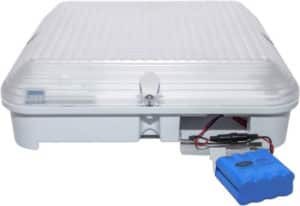This article about emergency lighting and getting your building emergency ready has been provided by Tracey Wyber, Trackie Industries.
In an emergency, we want things we have designed to save lives to work properly. Seatbelts, airbags, smoke alarms etc. In that category, we should also include the humble emergency light.
The emergency light is the most important essential service in high-rise and public buildings when the power goes down. When this occurs, the lifts stop working, water is unable to be pumped to the roof and fresh air stops being distributed throughout the building.
With the lifts not operating, the only way to exit a high-rise building is by the fire stairs. As most fire stairs have no natural light, they rely fully on the emergency lighting system operating on battery backup.
 Whilst there is no immediate threat to safety, there is a small window of time to be able to exit the building safely – the 90 minute period that the emergency lights operate for. Emergency lighting performance is the insurance policy to ensure the safe evacuation of all building occupants.
Whilst there is no immediate threat to safety, there is a small window of time to be able to exit the building safely – the 90 minute period that the emergency lights operate for. Emergency lighting performance is the insurance policy to ensure the safe evacuation of all building occupants.
The challenge with emergency lighting in the past has been that the standard fluorescent emergency light is time consuming and expensive to maintain in 100% operating condition, especially when it relates to battery failures.
The good news is that many of these problems have largely been overcome in the last 5 years with the new LED technology being inherently more reliable.
Well-designed lights offer features such as easy removal for repair and upgrade and / or an accessible battery drawer so that battery replacement can be simply undertaken without isolating the mains power. These simple design features substantially reduce the time and cost of repairs and maintenance.
What should building managers look for?
Many buildings contain emergency lighting systems that are well past their use-by dates. A trigger event such as a blackout or a biannual emergency lighting test failure report represents an ideal opportunity to replace fluorescent technology with the latest LED technology.
Engaging a professional company is critical as selecting an approved light and maintaining emergency and normal lighting levels is essential. In many cases, if the right lights are chosen, the cost to upgrade is significantly reduced as the capital cost is offset by energy savings.
The impact of a total building power failure can be massive – business disruption, equipment failure, data backup & stock / perishables loss risks. All of these are inconvenient however not life-threatening. A non functioning emergency lighting system could well be.
With modern LED emergency lighting technology improvements, there are fewer excuses to be caught in the dark.
Tracey Wyber
E: tracey@trackieind.com.au
W: Trackie Industries
This post appears in Strata News #267.
Read next:
- Apartment Block Residents Stressed by Fan Noise [Case Study]
- Car Park Lighting: Get Compliant & Improve Safety
Visit our Maintenance and Common Property OR Strata Topics by State pages.
After a free PDF of this article Log into your existing LookUpStrata Account to download the printable file. Not a member? Simple – join for free on our Registration page.
Have a question about emergency lighting or something to add to the article? Leave a comment below.

The LED Lights are far better now than they were a few years ago, that said, the requirement under the standard is for the lights to be tested every six months. this test is a 90 minute test with the power off, i.e in battery mode, lights will often be able to run longer.
One of the major problems we see, when we take on a new site is not enough exit and “spit fire” emergency lights. We perform the test, as per the standard, for 90 minutes, and there are areas which are in total darkness. We look for the failed unit, nothing there. hence we have to wire in a new additional unit
We also find the local “handy-man” (or the cleaning FM Company) has done a great job of replacing failed emergency lights with standard fittings, hence we do the 90 minute test and, nothing works, because its been replaced with a normal light fittings. (we had this across an entire site on one occasion).
Plant rooms, storage rooms, IT server rooms, newly constructed rooms (without certification) and others, are often found with no emergency light or exit light fittings at all. Picture the image of a smokey dark room and a person trying to find the door on their hands and knees. these rooms need emergency light fittings too!
We have sooooo many “horror” stories for you, keep these lights tested, better to have too many emergency light fittings than not enough.
Drop a line to Nikki if you need our help or a quick call 1300 920 752,